Highlights for sheep
- Australian lamb markets have been relatively steady over the past month. Prices dipped through the middle of February before recovering following rains across large parts of eastern Australia. The National Trade Lamb Indicator is currently around 780 c/kg. This marks a 2.2 per cent increase over the past month and up 28.3 per cent from this time last year. Conditions remain dry in many sheep producing regions across Australia. Soil moisture levels are currently well below average which has limited restocker interest.
- Lamb supply has remained elevated throughout February. The influx of lambs that were carried over from the second half of 2024 continue to flow through the market. Lamb slaughter averaged 500 thousand head per week in February. This marks a five per cent increase from February last year and 28 per cent above the five-year average for the month. Mutton slaughter has also been strong throughout February. Combined sheep and lamb slaughter has consistently exceeded 700 thousand head per week. This highlights how strong Australia’s processing capacity is currently.
- Lamb prices are expected to be steady throughout March. Continued strong supply and dry seasonal conditions will limit upside. Moving through to the end of June lamb prices should see support as the supply of lamb and mutton starts to slow. This will require processors have to compete harder to secure stock. The impacts of the ongoing trade conflict may see consumer demand impacted from Australia’s major export markets.

Joe Boyle
Joe is our Insights specialist for sheep and wool industries. He hails from a cropping and sheep farm in northwestern Victoria and has studied a Bachelor of Agriculture at the University of Melbourne.
Bendigo Bank Agribusiness Insights publication(s) are for information purposes only and contain unsolicited general information, without regard to any individual objectives, financial situation or needs. Please refer to the terms and conditions.





